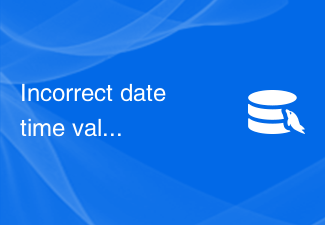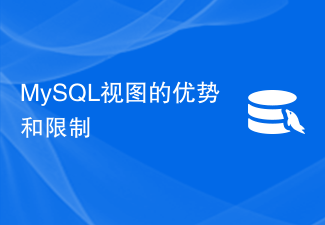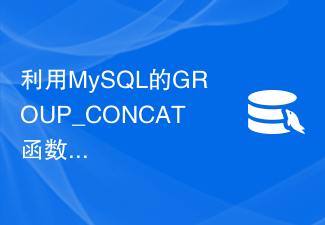 Database
Database Mysql Tutorial
Mysql Tutorial MySQL and Lua: How to implement data addition, deletion, modification and query functions
MySQL and Lua: How to implement data addition, deletion, modification and query functionsMySQL and Lua: How to implement data addition, deletion, modification and query functions
Abstract: This article will introduce how to use the Lua programming language to interact with the MySQL database to implement data addition, deletion, modification and query operations. We will discuss how to connect to a MySQL database, execute queries and obtain result sets, and how to perform insert, update, and delete operations.
Introduction:
MySQL is one of the most popular relational databases today, and Lua is a lightweight and scalable scripting language. Combining the two, we can use the powerful text processing and programming capabilities provided by Lua to operate the MySQL database and implement various data addition, deletion, modification and query functions.
- Connect to MySQL database
First, we need to connect to the MySQL database for data operations. Lua uses the LuaSQL library to interact with the MySQL database, so we first need to install the LuaSQL library. Below is the sample code to connect to the MySQL database:
local luasql = require "luasql.mysql"
local env = assert(luasql.mysql())
-- 连接到MySQL数据库
local conn = assert(env:connect("database", "username", "password", "localhost", 3306))In this example, we use the LuaSQL library to connect to the MySQL database, where "database" is the database name, "username" and "password" " is the username and password of the database, "localhost" is the address of the MySQL server, and 3306 is the port number of the MySQL server.
- Query data
Once we are connected to the MySQL database, we can execute the query statement and obtain the result set. The following is a simple sample code for querying data:
-- 查询数据
local cursor = assert(conn:execute("SELECT * FROM tablename"))
-- 获取结果集中的数据
local row = cursor:fetch({}, "a")
while row do
print(row.field1, row.field2)
row = cursor:fetch(row, "a")
endIn this example, we use the execute function to execute a SELECT statement and obtain the data in the result set through the fetch function. We can then loop through all the data and process it.
- Insert data
To insert new data into the MySQL database, we can use the execute function to execute the insert statement. The following is a sample code for inserting data:
-- 插入数据
local insert_query = "INSERT INTO tablename (field1, field2) VALUES ('value1', 'value2')"
local res = assert(conn:execute(insert_query))In this example, we use the execute function to execute an INSERT statement and pass it the data to be inserted as a string.
- Update data
To update existing data in the MySQL database, we can use the execute function to execute an update statement. The following is a sample code for updating data:
-- 更新数据 local update_query = "UPDATE tablename SET field1 = 'newvalue' WHERE condition" local res = assert(conn:execute(update_query))
In this example, we use the execute function to execute an UPDATE statement and use the SET clause to set the field to be updated and the new value.
- Delete data
If we want to delete data from the MySQL database, we can also use the execute function to execute the delete statement. The following is a sample code for deleting data:
-- 删除数据 local delete_query = "DELETE FROM tablename WHERE condition" local res = assert(conn:execute(delete_query))
In this example, we use the execute function to execute a DELETE statement and use the WHERE clause to specify the conditions for the data to be deleted.
Conclusion:
By combining the programming capabilities of Lua and the data storage capabilities of MySQL, we can easily implement the data addition, deletion, modification and query functions. This article describes how to use the Lua programming language to interact with a MySQL database and provides some code examples to help readers practice these operations. Whether in small applications or large projects, the combination of Lua and MySQL can provide us with powerful data manipulation capabilities.
The above is the detailed content of MySQL and Lua: How to implement data addition, deletion, modification and query functions. For more information, please follow other related articles on the PHP Chinese website!
 Incorrect datetime value: 'datetime_value' - 如何解决MySQL报错:日期时间值不正确Oct 05, 2023 pm 12:22 PM
Incorrect datetime value: 'datetime_value' - 如何解决MySQL报错:日期时间值不正确Oct 05, 2023 pm 12:22 PM如何解决MySQL报错:日期时间值不正确MySQL是一种常用的关系型数据库管理系统,它提供了强大的数据存储和查询功能。在使用MySQL的过程中,我们经常会遇到一些错误提示,其中之一就是"日期时间值不正确"(Incorrectdatetimevalue)。这个错误通常是由于我们插入或更新数据库中的日期时间字段时,所提供的值格式不正确而引起的。为了解决这个问
 MySQL视图的优势和限制Mar 15, 2024 pm 09:09 PM
MySQL视图的优势和限制Mar 15, 2024 pm 09:09 PMMySQL视图的优势和限制在MySQL数据库中,视图是一种虚拟的表,由一个查询语句定义,可以简化复杂的查询操作,提高代码的可读性和可维护性。本文将介绍MySQL视图的优势和限制,并提供具体的代码示例。一、优势简化复杂查询:视图可以将复杂的查询逻辑封装起来,只需在需要的地方调用视图即可,不再需要重复编写复杂的查询语句。提高性能:通过视图,可以将一些常用的查询结
 如何在MySQL中创建买菜系统的订单明细表Nov 01, 2023 am 08:17 AM
如何在MySQL中创建买菜系统的订单明细表Nov 01, 2023 am 08:17 AM如何在MySQL中创建买菜系统的订单明细表在开发买菜系统时,订单明细表是一个非常重要的数据表。它记录了每个订单中的商品明细,包括商品ID、数量、价格等信息。本文将介绍如何在MySQL中创建买菜系统的订单明细表,并附上具体的代码示例。创建数据库和数据表首先,在MySQL中创建一个名为buy_vegetables的数据库。可以使用以下命令:CREATEDATA
 MySQL数据库对大小写敏感吗?Mar 16, 2024 am 08:21 AM
MySQL数据库对大小写敏感吗?Mar 16, 2024 am 08:21 AMMySQL数据库对大小写敏感吗?需要具体代码示例在使用MySQL数据库时,有时会遇到大小写敏感的问题,即在查询、插入或更新数据时,不同大小写的情况可能会导致不同的结果。MySQL数据库在对大小写的处理上是有一定的敏感性的,下面我们通过具体的代码示例来深入探讨MySQL数据库对大小写的敏感性。首先,我们来创建一个简单的数据库表格,用来进行示例演示:CREATE
 一步步学习:如何用PHP和MySQL构建购物车功能Mar 15, 2024 pm 03:21 PM
一步步学习:如何用PHP和MySQL构建购物车功能Mar 15, 2024 pm 03:21 PM在本篇文章中,我们将一步步学习如何使用PHP和MySQL构建一个简单的购物车功能。购物车是电子商务网站不可或缺的一部分,它允许用户将想要购买的商品暂时存放在其中,并实现对商品的增删改查操作。通过学习本文,你将了解到如何利用PHP处理逻辑和MySQL存储数据,来实现一个完整的购物车功能。第一步:创建数据库首先,我们需要创建一个数据库来存储商品信息。打开MySQ
 如何使用MySQL和Ruby实现一个简单的数据备份功能Sep 21, 2023 am 10:05 AM
如何使用MySQL和Ruby实现一个简单的数据备份功能Sep 21, 2023 am 10:05 AM如何使用MySQL和Ruby实现一个简单的数据备份功能随着互联网的迅速发展和技术的进步,数据备份已经成为所有企业和个人必备的重要工作。MySQL和Ruby是两个广泛应用于数据处理和管理的强大工具。本文将介绍如何使用MySQL和Ruby实现一个简单的数据备份功能,并提供了具体的代码示例。一、准备工作在开始实现数据备份功能之前,我们需要满足以下几个前提条件:安装
 MySQL数据库管理:使用Go语言的最佳实践Jun 17, 2023 pm 02:04 PM
MySQL数据库管理:使用Go语言的最佳实践Jun 17, 2023 pm 02:04 PMMySQL是目前最流行的关系型数据库之一,在各种Web应用程序和企业软件中都被广泛使用。MySQL数据库的管理很重要,因为它影响到数据库的性能和稳定性。并且使用Go语言来管理MySQL数据库具有诸多优势。因此,本文旨在探讨使用Go语言时MySQL数据库管理的最佳实践。使用ORM框架ORM(对象关系映射)框架是一种将数据库操作和编程语言的对象模型关联的技术。O
 利用MySQL的GROUP_CONCAT函数将多行数据合并成一行Jul 25, 2023 pm 07:54 PM
利用MySQL的GROUP_CONCAT函数将多行数据合并成一行Jul 25, 2023 pm 07:54 PM利用MySQL的GROUP_CONCAT函数将多行数据合并成一行在实际的数据处理过程中,有时候我们需要将多行数据合并成一行,方便后续的分析和处理。MySQL的GROUP_CONCAT函数可以帮助我们实现这个功能。本文将介绍GROUP_CONCAT函数的用法,并提供一些常见场景下的代码示例。GROUP_CONCAT函数是MySQL中用于合并字符串的聚合函数,它


Hot AI Tools

Undresser.AI Undress
AI-powered app for creating realistic nude photos

AI Clothes Remover
Online AI tool for removing clothes from photos.

Undress AI Tool
Undress images for free

Clothoff.io
AI clothes remover

AI Hentai Generator
Generate AI Hentai for free.

Hot Article

Hot Tools

MinGW - Minimalist GNU for Windows
This project is in the process of being migrated to osdn.net/projects/mingw, you can continue to follow us there. MinGW: A native Windows port of the GNU Compiler Collection (GCC), freely distributable import libraries and header files for building native Windows applications; includes extensions to the MSVC runtime to support C99 functionality. All MinGW software can run on 64-bit Windows platforms.

mPDF
mPDF is a PHP library that can generate PDF files from UTF-8 encoded HTML. The original author, Ian Back, wrote mPDF to output PDF files "on the fly" from his website and handle different languages. It is slower than original scripts like HTML2FPDF and produces larger files when using Unicode fonts, but supports CSS styles etc. and has a lot of enhancements. Supports almost all languages, including RTL (Arabic and Hebrew) and CJK (Chinese, Japanese and Korean). Supports nested block-level elements (such as P, DIV),

WebStorm Mac version
Useful JavaScript development tools

Atom editor mac version download
The most popular open source editor

ZendStudio 13.5.1 Mac
Powerful PHP integrated development environment





